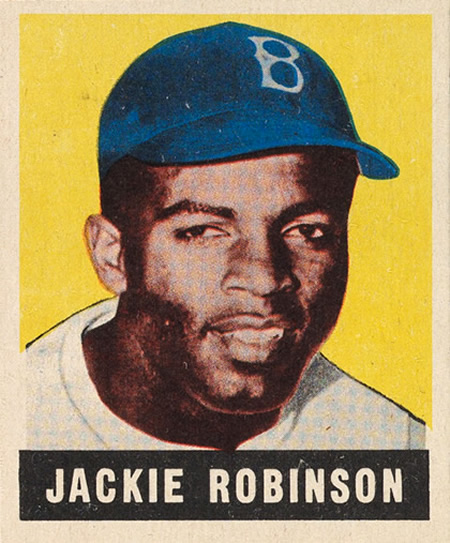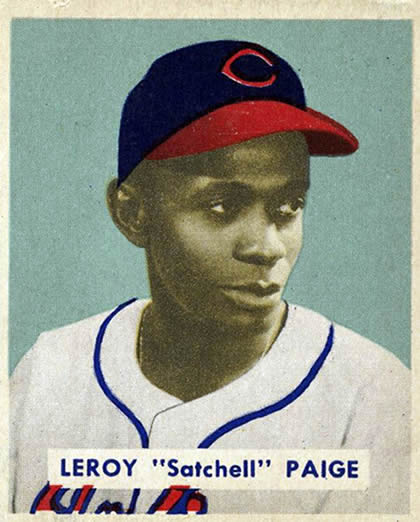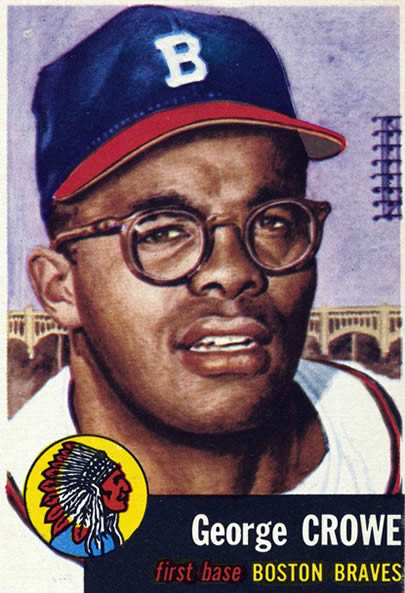|
They Broke the Color BarrierBefore there was a Martin, a Malcolm or a Rosa... there was a Jackie.Images from the Met Museum exhibition, Breaking the Color Barrier in Major League Baseball, now on view through June 17, 2012 in Gallery 774. Left: Leaf Gum, Co., Chicago, IL. Jackie Robinson, Brooklyn Dodgers, from Baseball's Greatest Stars (R401-1), no. 79. 1948–1949. Commercial Chromolithograph. |
Sixty-five years ago this month, April 15, 1947, Jackie Robinson swung a bat and shattered baseball's color line. On Sunday, major league ballparks will celebrate Robinson. All big-league players will wear Jackie Robinson’s number - 42 - the only number in sports history to ever receive a permanent retirement. But Jackie Robinson was more than a tremendous baseball player, he was one of the most important civil rights figures in American history. Dr. Martin Luther King said of Robinson, “Back in the days when integration wasn’t fashionable, he underwent the trauma and humiliation and the loneliness which comes with being a pilgrim walking the lonesome byways toward the high road of freedom. He was a sit-inner before sit-ins, a freedom rider before freedom rides.” Now until June 17, 2012, you can see one of the most comprehensive collections of players who moved from the Negro Leagues into the Major Leagues in the Metropolitan Museum of Art's exhibition, Breaking the Color Barrier in Major League Baseball. In October 1945 Wesley Branch Rickey (1881–1965), general manager of the Brooklyn Dodgers, signed Jack Roosevelt Robinson (1919–1972) from the Negro League's Kansas City Monarchs to the Dodgers organization, thus breaking the color barrier that had existed in professional baseball since 1889. On April 15, 1947, Robinson took the field for the first time as a Brooklyn Dodger, earning the title "Rookie of the Year" in the National League at the end of the season with 12 homers, 29 steals, and a .297 batting average. Right: Bowman Gum Company. Leroy "Satchell" Paige, Pitcher, Cleveland indians, from a series of 240 (no. 224) 1949; Commercial color lithograph. |
|
|---|
|
Shortly after Robinson's debut, Larry Doby was signed by the Cleveland Indians, who then brought over the Negro League's star pitcher, Satchel Paige, to join Doby the following year. With these developments, baseball's long-entrenched segregation, slowly, began to crumble; it took another twelve years for the Boston Red Sox—the last team to integrate—to hire Elijah "Pumpsie" Green, three years after Robinson retired from the game.
Robinson entered a hostile arena, carrying the hopes and dreams of the entire Black race on his shoulders. He faced death threats and unspeakable obscenities. Never before in sports history, and never since, had so much been riding on one athlete. If he succeded, he succeeded for all Blacks. It would confirm that Black should have the same opportunities as Whites. If he failed, it was a public declaration of the long-held belief by many Whites, that Blacks were inferior. Jackie Robinson succeeded beyond their wildest dreams and both Black and White America was forever changed.
The selection of baseball cards in Breaking the Color Barrier in Major League Baseball, at the Met Museum, is taken from the Jefferson R. Burdick Collection. The more than thirty thousand baseball cards collected by Burdick date from 1887 to 1959 and represent the most comprehensive collection outside of the Baseball Hall of Fame in Cooperstown, New York. Left: Topps Chewing Gum Company. George D. Crowe, First Base, Boston Braves, from the series Dugout Quiz (no.3) 1953; Commercial color lithograph. Topps baseball cards used courtesy of the Topps Company, Inc.
|
|---|
|
|---|


